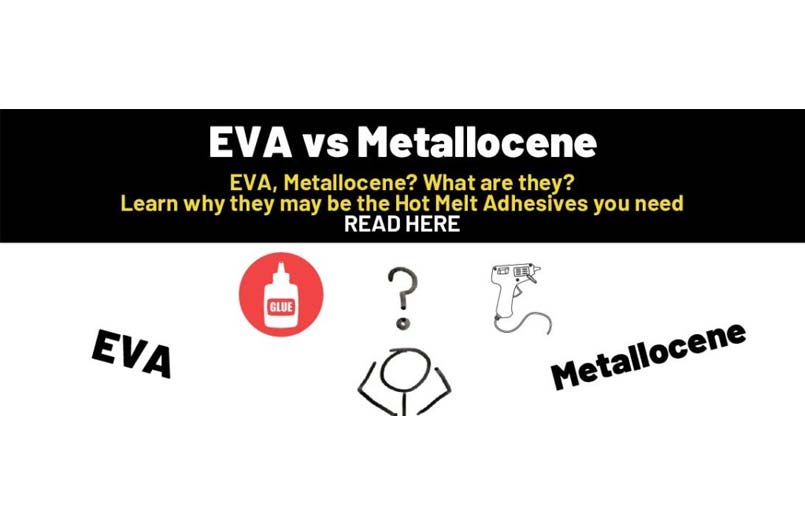EVA vs Metallocene - Hot Melt Comparison

Action Adhesives are leaders in the Industrial Adhesives market in Ireland. Our technical team have assembled the most comprehensive range of top quality hot-melt products based on over 20 years’ experience.
What are Hot Melts?
Hot Melt Adhesives are solid materials that melt at relatively low temperature (typically above 80°C). These are commonly applied between 125°C to 177°C. Once cooled, the materials solidify again. This will ensure cohesion and the ultimate adhesion of the bonded surfaces.
Properties of Hot Melt Adhesives
The main properties of hot melt adhesives are:
- 100% solids
- Thermoplastic
- Applied in a molten state
- Set by cooling
- Fast setting
- High adhesion
- Wide variety of formulations
In most cases, a prescribed amount of hot fluid adhesive is applied to the surface to be bonded. It is brought into contact with the surface to be bonded and compression is applied. After the adhesive has cooled below its solidification point, the substrates are bonded. This process is illustrated below:
- Transfer – Both substrates must have an ample amount of adhesive.
- Wet Out – Characterized by the ability to flow and evenly coat the surface.
- Penetrate – Adhesive dives into the substrate’s fibers and begins interlocking.
- Solidify – Final stages of cooling when the adhesive’s internal strength becomes greater than that of the substrate.

Hot Melts are made from 4 main ingredients:
- A backbone polymer like EVA, mPO, rubber, etc.
- Natural or synthetic wax to act as a diluent and aid in set time, temperature resistance, and adhesion
- A natural or synthetic tackifying resin. Examples are a tree resin to impart tack and ultimate adhesion
- An antioxidant to impart stability at application temperatures
Here we will focus on the two main types of backbone polymers used in the majority of Packaging Hot Melts used. These are an EVA and mPO (Metallocene).
What is EVA?
EVA, or ethylene vinyl acetate copolymer, has been the mainstay and workhorse of packaging hot melts for well over 50 years now. Formulation of an EVA can done with a variety of materials. These are customisable to the needs of specific markets. This can include food packaging that needs adhesion in blast freezer conditions as low as -40°C or shipping packages that may see temperatures in excess of 70°C in transit. The formulation of the specific EVA can be used to adhere substrates from simple paper to wax or plastic.
What is Metallocene?
Metallocene, or mPO polymers, are relatively new to packaging hot melts. The first viable adhesives made with these polymers hit the market in the mid to late 1990’s. They offer some unique advantages over EVA formulations.
Metallocenes offer:
- Enhanced resistance to char formation upon exposure to the heat in application equipment.
- A metallocene is less dense, contains a lower volume verus an EVA hot melt. This enables the use of less adhesive to achieve a strong bond.
- Save up to 40% by switching from EVA to Metallocene.
- Metallocenes offer the formulator a wider window of end use temperature resistance. This ensures the same adhesive can offer both freezer and high temperature resistance.
Metallocenes are not always perferable to EVA hot melts. Each has their place in the industry.
- Char formation – Metallocenes are typically more thermally stable in your equipment.
- Low temperature EVA offerings are unique. They offer excellent performance without reaching sufficient temperature to form char.
- Metallocenes have a very wide range of end use temperature resistance (freezer to heat), if your need is only one end or the other, EVA may be a very good choice for you.
- Sometimes a difficult to stick substrate may need a more traditional EVA formulation to adhere it adequately.
Industry uses for Hot Melt Adhesives & Metallocene
Typical applications for EVA or Metallocene hot melts include:
- Packaging (End of line case and carton sealing)
- Bookbinding (Spine glue, Hinge glue)
- Bottle Labeling (label attachment, cap lining)
- Bags (bottom seals, multiwall attachment, pinch seals)
- Straw attachment
- Window Blinds
- Tile Displays
- Sign & Display Manufacturing
- Food Processing (Carton Sealing)
- Pharmaceutical (Carton Sealing)
- Wood construction (edgebanding, profile wrapping)
Summary
If you think a hot melt might be suitable for your business, contact our team for expert guidance. Our adhesive experts will review your unique situation and help you decide which hot melt makes the most sense for you.
We have a combined experience of 75 years in the Industrial Adhesives packaging industry. We can offer an audit your line, run tests on your substrates and offer you the most economically effective solution to your adhesive needs.
Hot Melt Equipment
Interested in hot melt adhesives? Need equipment? Technical issues slowing equipment progress? Our team are the official distributor of Meler hot melt equipment. They are ready and available to support all your Hot Melt needs.


